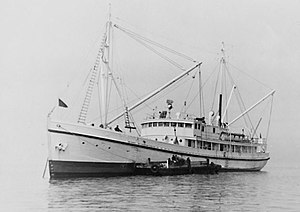US FWS Penguin II

| |
| Name | U.S. Army Lt. Raymond Zussman (FS-246) |
| Namesake | recipient |
| Builder | Northwestern Shipbuilding Company, Bellingham, Washington |
| Completed | June 1944 |
| Fate | Sold to U.S. Fish and Wildlife Service 9 June 1950 |
| Name | MV Lt. Raymond Zussman |
| Namesake | Previous name retained |
| Acquired | From United States Army 9 June 1950 |
| Commissioned | 1950 |
| Renamed | US FWS Penguin II 21 September 1950 |
| Namesake | Pribilof tender ," 1930–1950 |
| Decommissioned | 1963 |
| Homeport | Seattle, Washington |
| Fate | Sold 18 August 1964 |
| Status | Extant 1976 as Colombian commercial vessel Aurora |
| General characteristics as Fish and Wildlife Service cargo ship | |
| Type | U.S. Army Design 342 Freight and Supply (FS) |
| Tonnage | 540 Gross register tons |
| Length | 148 ft (45 m) |
| Beam | 33 ft 3 in (10.13 m) |
| Propulsion | 875- |
| Capacity | 20 passengers; 15,000 cubic meters ) of cargo |
| Crew | 14 |
| Sensors and processing systems | Radar |
| Notes | Refrigeration added 1951 |
US FWS Penguin II was an American
Construction and U.S. Army service
Fish and Wildlife Service
On 21 April 1910, the
On the night of 3 June 1950, the FWS Pribilof tender
Penguin II underwent renovations in February 1951 which gave her more cabin area, doubled her cargo capacity, and gave her ten times the
In addition to making voyages between Seattle and the Pribilofs, Penguin II also made trips within the Pribilofs between
By the early 1960s, the demand for supplies in the Pribilof Islands had increased to the point that the BCF considered Penguin II too small to serve as its Pribilof tender.[1] In October 1962, the U.S. Army loaned the refrigerated cargo ship FSR-791 to the BCF, which placed her in service as the new Pribilof tender US FWS Pribilof in 1963.[9] Consequently, the BCF decommissioned Penguin II in 1963 and sold her at auction in Seattle on 18 August 1964.[1]
Later career
Penguin II was sold into commercial service. She was sighted in the Port of Los Angeles at Los Angeles, California, in 1976, operating under the Colombian flag with the name Aurora and with her home port at San Andrés in Colombia.[1]
Footnotes
- ^ Martinolich Repair, San Francisco, California built 5, Northwestern Shipbuilding, Bellingham, Washington built 6 and Pacific Shipways, Anacortes, Washington built 4.
References
- ^ a b c d e f g h i j k l m n o p q r s t u v AFSC Historical Corner: Penguin II, Pribilof Islands Tender (1950-64) Retrieved September 6, 2018
- ^ AFSC Historical Corner: Brown Bear, Grizzly Bear & Black Bear - "Bear" Boats Retrieved September 14, 2018
- ^ LCCN 87015514.
- ^ Jackson, Ramon (2007). "Army FP/FS Vessels". Retrieved 3 October 2020.
- ^ Colton, Tim (November 28, 2012). "U.S. Army Coastal Freighters (F, FS) Built During WWII". ShipbuildingHistory. Retrieved 3 October 2020.
- ^ Colton, Tim (January 20, 2015). "Northwestern Shipbuilding, South Bellingham WA". ShipbuildingHistory. Retrieved 3 October 2020.
- ^ a b c d AFSC Historical Corner: The Pribilof Islands Tender Vessels Retrieved September 4, 2018
- ^ a b c d AFSC Historical Corner: Penguin, Pribilof Tender for 20 Years (1930-50) Retrieved September 6, 2018
- ^ AFSC Historical Corner: Pribilof, Bureau's Last Pribilof Tender (1964-75) Retrieved September 4, 2018
